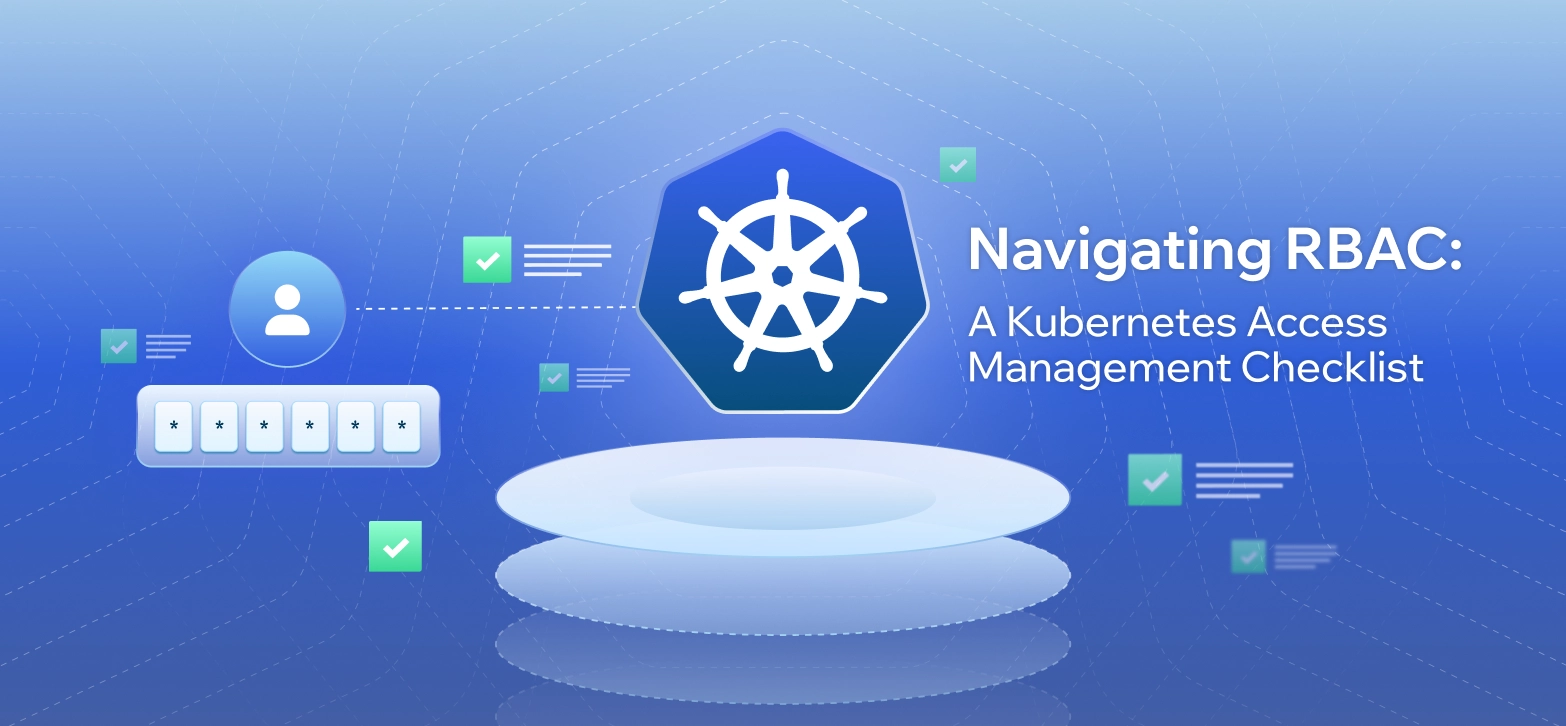In the world of Kubernetes, managing access and permissions is not just a best practice—it’s a necessity. With the rise of container orchestration, the need for robust Role-Based Access Control (RBAC) has become critical. Misconfigured access controls can lead to significant security risks, making it essential for organizations to implement effective RBAC strategies.
This checklist serves as your go-to guide to ensure that your Kubernetes RBAC implementation is both secure and efficient. From defining roles and permissions to monitoring access patterns, we’ve got you covered with the essential steps to strengthen your Kubernetes environment.
Kubernetes RBAC Access Management Checklist
1. Understand the Basics of RBAC
 Familiarize yourself with key concepts:
Familiarize yourself with key concepts:
- Roles: These define a set of permissions (verbs) within a specific namespace, such as get, list, create, or delete for various resources.
- RoleBindings: Bind a Role to a user, group, or service account within a specific namespace, granting the defined permissions.
- ClusterRoles: Similar to Roles but apply to all namespaces in the cluster, useful for global permissions.
- ClusterRoleBindings: Bind a ClusterRole to users/groups across the entire cluster, providing cluster-wide access.
2. Understand the Basics of RBAC
 Identify access needs:
Identify access needs:
- Conduct a needs assessment to determine who requires access to various resources.
- Analyze user roles in your organization:
- Developers: May need create and edit permissions.
- Admins: Require broader access, including managing roles and bindings.
- Auditors: Should have read-only access to ensure compliance.
- Ensure clarity on any temporary access needs for projects or specific tasks.
3. Use Namespaces Wisely
 Assign RBAC roles based on namespaces:
Assign RBAC roles based on namespaces:
- Namespaces help isolate environments for different teams or projects. By assigning roles per namespace, you reduce the risk of unauthorized access across teams.
- Structure your namespaces to reflect your organizational hierarchy, such as development, staging, and production, to streamline permissions management.
4.Create Minimal Roles
 Follow the principle of least privilege:
Follow the principle of least privilege:
- Design Roles that grant only the necessary permissions required for users to perform their tasks. This minimizes potential security risks.
- For example, instead of granting full access to all resources, specify actions for particular resources, like allowing a developer to only get and list Pods in their namespace.
5. Leverage RoleBindings
 Use RoleBindings effectively:
Use RoleBindings effectively:
- RoleBindings are essential for connecting users and roles. Ensure each user or service account has appropriate RoleBindings that reflect their responsibilities without over-provisioning.
- Keep RoleBindings organized by clearly documenting their purpose and scope for easier audits.
6. Utilize ClusterRoles for Global Access
 Define ClusterRoles for broader permissions:
Define ClusterRoles for broader permissions:
- Use ClusterRoles when users need to perform actions across multiple namespaces, such as monitoring or logging.
- Be cautious when assigning ClusterRoleBindings to avoid unintentionally granting excessive permissions.
7. Audit Your RBAC Policies Regularly
 Conduct regular audits:
Conduct regular audits:
- Regular audits help maintain security and compliance. Schedule periodic reviews of role assignments and permissions to ensure they align with current organizational needs.
- Utilize tools like kubectl commands to check RoleBindings and ClusterRoleBindings to identify any outdated or excessive permissions.
8. Monitor and Log RBAC Activity
 Implement monitoring and logging solutions:
Implement monitoring and logging solutions:
- Leverage Kubernetes audit logs to track who accessed what resources and when.
- Set up monitoring tools like Prometheus and Grafana to visualize access patterns and detect anomalies in user behavior.
9. Test Your RBAC Configurations
 Test in a staging environment:
Test in a staging environment:
- Before deploying RBAC changes to production, validate your configurations in a staging environment.
- Use test users with different roles to ensure they can only perform actions they are permitted to do, identifying any permission overlaps.
10. Educate Your Team
 Provide training on RBAC best practices:
Provide training on RBAC best practices:
- Conduct regular training sessions to ensure team members understand RBAC and the significance of access control.
- Provide resources, such as documentation and tutorials, to keep everyone informed on secure access practices and updates in Kubernetes.
How Procyon Can Help with RBAC and Kubernetes Access Management
At Procyon, we understand that managing RBAC can be a challenging yet critical task for securing your Kubernetes environments. Our platform is designed to provide comprehensive support, enhancing your security posture while simplifying the management of access controls. Here’s how Procyon can elevate your RBAC implementation:
1. Automated Role Management
- Dynamic Role Creation: Procyon automates the creation and assignment of Roles and RoleBindings based on predefined policies. This means you can quickly adapt to changing organizational needs without the risk of human error.
- Template-Based Role Definitions: Our platform allows you to define role templates, which can be reused across different namespaces or clusters, ensuring consistency and reducing setup time.
2. Real-time Auditing and Monitoring
- Continuous Access Monitoring: Procyon provides real-time visibility into access patterns across your Kubernetes environment. This includes tracking who accessed what resources and when, enabling you to identify and respond to potential security threats swiftly.
- Comprehensive Audit Trails: With detailed audit logs, Procyon ensures compliance with internal and external regulations by providing a clear record of all access events and role assignments. These logs can be easily exported for further analysis or regulatory audits.
3. Anomaly Detection
- Behavioral Analysis: Procyon leverages machine learning algorithms to analyze user behavior and detect anomalies that may indicate unauthorized access attempts. This proactive approach helps mitigate risks before they escalate.
- Alerts and Notifications: Our system can generate alerts for unusual access patterns or failed authentication attempts, allowing your security team to take immediate action when necessary.
4. Simplified Role Assignment and Access Controls
- Self-Service Portal: Procyon features a user-friendly self-service portal that allows team members to request roles or permissions based on their specific needs. This streamlines the approval process and ensures that users have the access they need without overwhelming your administrators.
- Granular Access Controls: Our platform enables you to define granular access controls that are tailored to individual users or groups. This allows for precise permission management, ensuring that users only have access to the resources they need.
5. Policy Enforcement
- Centralized Policy Management: Procyon provides a centralized dashboard to manage RBAC policies across multiple Kubernetes clusters. You can easily enforce policies, ensuring consistent access controls and compliance throughout your environment.
- Integration with CI/CD Pipelines: Procyon can integrate with your CI/CD pipelines to enforce RBAC policies during application deployment. This ensures that new applications adhere to your security standards right from the start./li>
6. User Education and Training
- Access to Resources: Procyon offers comprehensive training materials, including tutorials and best practice guides, to help your team understand RBAC and access management effectively.
- Workshops and Webinars: We regularly host workshops and webinars led by industry experts, providing your team with insights into the latest trends and best practices in Kubernetes security and RBAC management.
7. Compliance Support
- Regulatory Compliance: Procyon assists in maintaining compliance with industry regulations such as GDPR, HIPAA, and PCI-DSS by ensuring that your RBAC configurations align with required access controls and audit requirements.
- Automated Reporting: Generate compliance reports effortlessly, showcasing your RBAC implementation and access management practices to stakeholders and auditors.
8. Integration with Existing Security Tools
- Seamless Integrations: Procyon integrates with popular security tools and identity providers, enhancing your existing security infrastructure. This ensures that your RBAC policies are aligned with your broader security strategy.
- Single Sign-On (SSO) Capabilities: Leverage SSO integrations to streamline user access while maintaining robust security controls, simplifying the user experience while securing your environment.
Wrapping Up
Implementing and managing Kubernetes RBAC can feel overwhelming, but following this checklist can streamline the process and enhance your security posture. Remember, maintaining secure access control is an ongoing journey—stay vigilant, conduct regular audits, and empower your team with the knowledge they need to keep your cluster secure.
By investing time and effort into a robust RBAC strategy, supported by Procyon’s comprehensive platform, you can ensure that your Kubernetes environment remains safe, efficient, and aligned with your organization’s needs. Procyon empowers you to simplify access management while strengthening your security posture. Happy managing!

